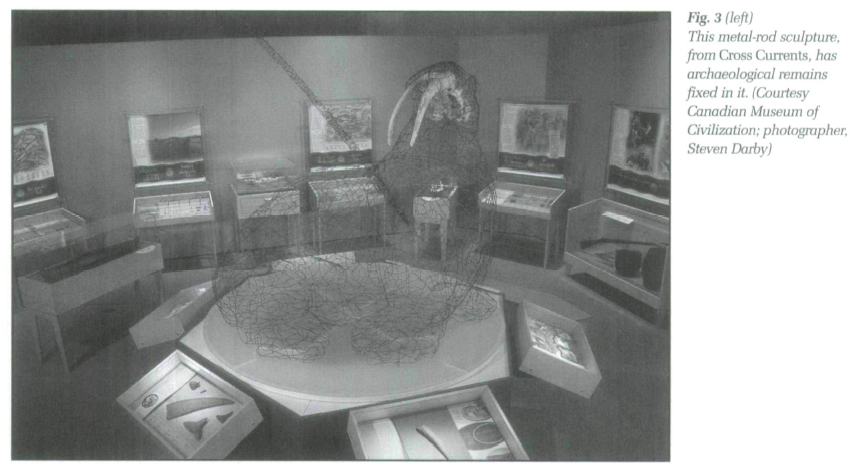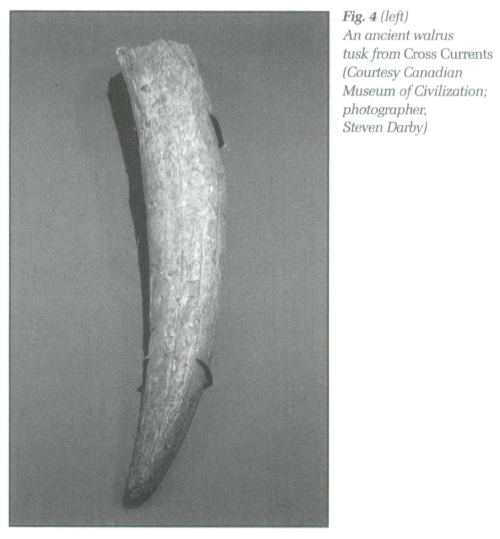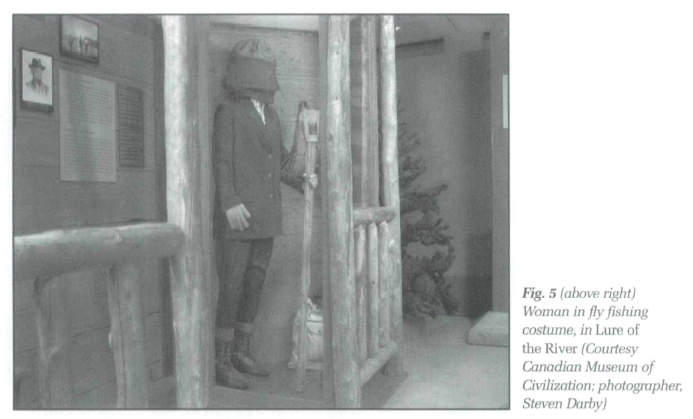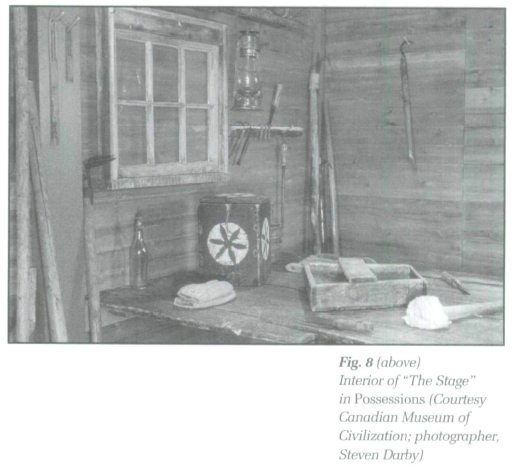Exhibit Reviews / Comptes rendus d'expositions
Lifelines:
Canada's East Coast Fisheries
1 Lifelines: Canada's East Coast Fisheries provides an interesting and at times innovative look at historical, cultural and controversial aspects of fisheries on the Atlantic coast. The exhibition is divided into six distinct sections, each dealing with an independent theme. These are produced by different museums, and thus comprise an untraditional "cocktail" of organization and presentation of varying scope. Together they present a multidisciplinary glimpse of life in the fisheries through the Pleistocene to, more or less, the modern day.
2 The visitor enters the exhibition by following a row of synthetic, shiny abstract interpretations of marine fish dangling from the ceiling through a dark corridor flanked on one side by historical artwork from the Art Gallery of Nova Scotia and on the other by suspended sail-like screens depicting photographs of the modern-day fishery. Etchings and paintings in the Art Gallery selection contain some marvelous pieces by John Neville among others.
 Display large image of Figure 1
Display large image of Figure 1 Display large image of Figure 2
Display large image of Figure 23 The next section, "Cross Currents: 500 Generations of Aboriginal Fishing in Atlantic Canada," contributed by the Canadian Museum of Civilization, follows fishing practices by Atlantic Aboriginal communities from the Pleistocene (about 10 000 years ago) to the arrival of Europeans. The focal point of the section is an intricate wire "net-like" sculpture of a large male walrus, strikingly impaled with an ominous crushed wire harpoon. Nestled within the head is an ancient tusked skull. The message is obvious, given that the walrus was hunted to extinction in eastern Canada. The exhibit contains a few wonderfully detailed and minuscule dioramas with crisp, clean and informative labels cleverly mounted on sailcloth displays. Further magnified details are concealed in drawers beneath the dioramas. Numerous archeological artifacts are displayed, most dealing with fishing techniques by Native peoples. These span finds from throughout Atlantic Canada, yet managed to miss some spectacular middens containing giant oyster shells located around the Atlantic shore of Nova Scotia and the head of the Bay of Fundy, that could have provided some exciting additions to this interesting display. A display of "one of the most spectacular archaeological finds" was of a rather lonely walrus tusk collected from L'Anse Amour, Labrador. A map showing L'Anse Amour with additional information on the archeological find itself would have been a useful accompaniment to this curiosity-provoking label since, in some cases, imagination is not everything!
4 Technically speaking, there were many errors in taxonomy — that for a museum and educational exhibit — warrant improved scrutiny. This may reflect the amalgam of exhibits from different sources, but the proximity of experts to consult at the Canadian Museum of Nature would have been sufficient to address this without too much effort. For example, the scientific names for striped bass (Morone saxatilis) and white perch (Morone americana) are incorrectly referred to as Roccus saxatilis and Roccus americanus respectively. Roccus is the old genus name, but the group's taxonomy was revised in 1967.1 Granted, most visitors care little about scientific names, but several translations between French and English also exhibited some faux pas! As an example of the former, the French term for redhorse is no longer "suceur" as indicated in the display, but now chevalier. Furthermore, the various species of redhorse are labeled as "rednose" (with the fish depicted being given a curiously red nose reminiscent of a reindeer we all know). The "meunier noir" is not a "black sucker" as indicated but a white sucker in English, and the "meunier rouge" isn't a "red sucker" as labeled, but a longnose sucker (vive la difference!). In French, crapet soleil refers specifically to the pumpkinseed sunfish rather than any generic sunfish, which could refer to a number of freshwater fishes or even a massive ocean-going creature weighing up to two tons.
5 As you meander into the next section, "Lure of the River: Sport Fishing in New Brunswick," an interactive computer display links you to a plethora of fisheries questions and answers. Further along in this section, the New Brunswick Museum addresses issues related to sport fishing in that province. Particularly fascinating is the portrayal of the sportsman's retreat in the 1800s. New Brunswick was visited regularly by the rich and famous from England and the United States, and their concept of a "roughing it" backwoods adventure included valet and gourmet silver service. This concept provided desperately needed employment in servicing and guiding income for several remote riverine communities.
 Display large image of Figure 3
Display large image of Figure 3 Display large image of Figure 4
Display large image of Figure 4 Display large image of Figure 5
Display large image of Figure 5 Display large image of Figure 6
Display large image of Figure 66 This portion will no doubt appeal to the present-day sport fisherman and fisherwoman among others. Displays are somewhat limited, with more to read than see here, but there are interesting collections of flies, photographs, journals and descriptions of life in a fishing lodge for both customers and guides alike. Tucked around the corner is an interesting tip of the hat to female participation in the backwoods retreat — including journal entries and period haute couture "contre les mouches noires." Some modem publications have been thrown into a bookcase in the period fishing lodge, thus inviting visitors to pause in nearby armchairs. There are also some wonderful "ye olde" postcards generously provided for the public pocket. There were a couple of empty holders for something else the public could help themselves too — they must have been even more popular than the postcards, since they were empty (in both official languages!).
7 The next section of Lifelines, entitled "The Cod Rush: The European Fishermen, 1497-1763," depicts the early history of European involvement in the east coast fishery. Portrayal of fishing fleet practices and the roles and lives of fishers is especially fascinating. Posters and display cases are cleverly arrayed in the shape of square-rigger sails, in keeping with the theme running through the artwork and aboriginal sections. This section was very well presented...you could nearly smell the salt cod hanging from the ropes!
8 In contrast, the next section "Lobster Tale: The Lobster Fishery of Prince Edward Island," comprised montages mounted on pseudo-lobster traps that resembled the decor of a bad seafood restaurant. The set also appeared jumbled, with no logical flow between the biology of the lobster, the historic development of the industry on the Island, or canning and processing, etc. We spent several minutes trying to figure out the purpose of a soldering contraption in one case, before coming to the text label several cases further away! The information text tends toward popular and "cute," for example, using a lobster in a dory from a historic can label as the section "logo." The biological details fall short of many aquaria or other museum displays. Lobsters, for example, are described as "garbage eaters" without qualifying what garbage is. Maybe if these gems did indeed eat garbage, our coastal waters would be a lot cleaner! The focus on the Island also detracts from the fact that lobsters constitute major fisheries throughout New Brunswick and Nova Scotia as well. Even though the display originates from Prince Edward Island, it should have been set in context for the Lifelines exhibition as "Canada's East Coast Fishery." On the whole, this section is the weakest of the overall exhibition — a somewhat poignant point, bearing in mind that lobsters constitute the most valuable component of Canada's east coast fisheries and are currently the focus of heated and high profile Aboriginal access debates.
9 Newfoundland is the focus of the next section, which examines material aspects as "possessions" of the fishery and fishers, including home life — "Possessions: The Material World of Newfoundland Fishing Families." The displays on loan from the Newfoundland Museum are lively, filled with curious and fascinating objects, and include some wonderful pieces of furniture. The display labels are innovative, in the form of binders of plasticized pages containing photographs of the objects on display. This is effective and obviates the need of the visitor to match numbers on a display panel with those in a complex display. The only negative points are a few poor quality photographs that demand imagination to place them in the set (e.g., the fishing net in the kitchen) but this does not detract from the overall display. A curious absence from the display — despite focus on regional art elsewhere in the exhibition — was David Blackwood's famous depictions of outport life including sealing, whaling and other fishing. Another idea for another day perhaps?
10 The last theme section, with a clever segue from the David Blackwood note, is "Swales and Whales: Atlantic Canada's Sea Mammal Harvest" focusing on sealing and whaling on the east coast. Displays of exploitation of marine mammals are juxtaposed with those of conservation and the protest movement. Though unusual, this dichotomy is extremely provocative, culminating with a powerful harpoon gun aimed at a magnificent film of whales breaching (a word of warning to those prone to motion-sickness, the film could induce queasiness!). The message is pointed (no harpoon pun intended) and effective and very well done, with the exception (yet again) of technical errors in biological details. Translations of hooded seals and harp seals are mixed up on one map, yet presented correctly on photographs on the opposite panel. Once again, with the Canadian Museum of Nature and the Department of Fisheries and Oceans nearby, someone should have been able to correct the erroneous labeling of hooded seal as "hood seal" especially since some of the exhibit material was borrowed from both these organizations!
11 The exhibition closes with a series of news clips from the CBC on recent controversial events in the fishery, interspersed with dramatic sketches of social commentary. This is artistically set up in a small auditorium furnished with undulating (horizontally!) benches — giving a whole new definition to "the wave." Entitled Tides of Change, this demonstration only partially reflects recent developments in the fishery, as does the exhibition on the whole. A message of conservation is implied throughout, which is valuable and educational on its own, but no effort is made to show how the fishery has changed since the moratorium in 1992. For example, the snow crab fishery has been exceedingly successful and profitable in the last decade. Moreover, many fishers now harvest non-traditional and abundant species, such as sea urchins, for overseas markets. There is also a significant international metamorphosis from purely capture fisheries to enhancement and aquaculture. In Atlantic Canada, this is particularly evident in mussels, oysters, clams, scallops, salmonids and even halibut, which in itself makes an interesting area for inclusion in future studies of this ilk — it is never possible to cover all issues in a single show and closure on video debate was an innovative way to signal this...
 Display large image of Figure 7
Display large image of Figure 7 Display large image of Figure 8
Display large image of Figure 8 Display large image of Figure 9
Display large image of Figure 912 Lifelines is well designed, informative and accessible to visitors of all backgrounds. Technical comments reflect the authors' familiarity with the subject, rather than serious divergences away from fact...in fact the exhibition's daring confrontation with debate is laudable and a definite strong point for future displays juxtaposing modern and historic reality.
Curatorial Statement
13 Lines attached to hooks, traps and trawls inextricably connect two communities, one offish and the other of people who harvest fish. Lifelines: Canada's East Coast Fisheries relates six parts of the story of these communities. The tale is of an abundant ocean that has sustained human life along our eastern shores for thousands of years and of people struggling to unlock its bounty. A precarious balance between the needs of each has been hard to achieve and eludes us still.
14 Lifelines has as its core message the necessity to establish that balance in the east coast fisheries. When the scales are tipped against the resources, we ourselves are endangered. Generally, we even seem to lack the knowledge required to attain a sustainable fishery. An important first step toward that goal is the wise consideration of related economic, social, environmental and political issues. Lifelines seeks to promote that process.
15 Lifelines pioneered a new approach to developing exhibitions, one in which a consortium of federal and provincial institutions and agencies having an interest in the history and future of Atlantic Canada worked jointly on an exhibition which is really a constellation of smaller exhibits. With sections on the aboriginal fishery, the sixteenth to eighteenth-century ground fishery, lobsters, sealing and whaling, the salmon sport fishery, and outport life, the exhibition provides a broad overview of a distinct economy and culture from prehistory to the twentieth century.
16 Preparations for exhibits on the Atlantic fisheries began independently over seven years ago at the Provincial Museum of Newfoundland and Labrador and the Canadian Museum of Civilization. With the cod stocks in crisis and the viability of many local economies in jeopardy, larger treatments of the subject seemed desirable. After extensive consultation, a meeting of historians, curators and interpretation planners was held in Halifax in February 1996 to assess the possibility of creating a comprehensive exhibition of the fishery.
17 By the end of that meeting, participants had agreed to a concept in which a series of exhibits, each dealing with one part of the fishery, would be created. These exhibits could be seen either alone or in combination with one or more of the other exhibits. Topics were identified for each partner and a common interpretative approach was adopted. Participating institutions selected topics that matched their mandates and resources. It was expected that information, while presented within the context of a single province, would be understood by our audience to apply generally region-wide. In addition, the plan called for a digital product to supplement the information found in the exhibits and to provide the overall context for them when they were being presented individually. A design protocol was also seen as necessary to ensure that each exhibit would look good with the others.
18 The CD-ROM, which first appeared in 1999, was the initial goal to be achieved. Entitled Balancing the Scales: Canada's East Coast Fisheries, it anticipated the content and interpretation of the exhibition. The same year, funding made available through a revamped exhibitions strategy of the Department of Canadian Heritage's Museums Assistance Program secured the participation of the east coast partners and ensured that the result would be the broadly based presentation originally envisioned.
19 Possessions: The Material World of Newfoundland Fishing Families opened in St. John's on 23 February 2000. It and the five other exhibits were brought together at the Canadian Museum of Civilization (CMC) in April 2001. In addition, for the CMC presentation, the Art Gallery of Nova Scotia contributed works portraying the fishery, and a video dealing with contemporary issues was produced by CMC in collaboration with the CBC. CMC also created a central walkway linking the exhibits and programmed additional interpretation and animation.
20 Most visitors are probably not aware that Lifelines is in fact six exhibits, each with its own curator and designer and fabricated in five different locations. Yet that individuality provides pacing and variety, which serve different tastes and keeps the experience for visitors fresh. Visitor surveys indicate that two exhibits having strikingly different curatorial and design approaches, Possessions (Provincial Museum of Newfoundland and Labrador) and A Lobster Tale (Prince Edward Island Museum and Heritage Foundation), are also two of the more highly applauded exhibits.
21 Following its presentation in the national capital region, Lifelines will begin its tour among the partners with stops in Saint John, St John's and other venues in Newfoundland, various sites on Prince Edward Island, and Stellarton, Nova Scotia. Interest has been expressed in receiving the exhibit in other parts of Canada and abroad. Each exhibit may be seen further in its province of origin.
22 Wherever they appear, Lifelines and its individual exhibits are dedicated to past generations of fishermen, and to their families and communities, who have lived by harvesting the sea's bounty and to future generations who will follow in their wake, if we can balance the scales.
Author's note: on 1 May 2002, Lifelines: Canada's East Coast Fisheries was given an Award for Outstanding Achievement by the Canadian Museums Association at its annual meeting in Calgary, Alberta. The Awards Committee noted that the exhibition "was nationally significant, exceeded the current standard of practice and is a useful example that demonstrates creativity, leadership and effective use of resources."